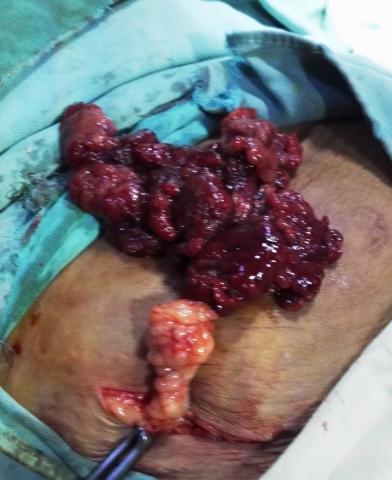ACUTE ABDOMEN DUE TO PRIMARY OMENTAL TORSION: VERY UNCOMMON PRESENTATION
BACKGROUND Primary torsion of the greater omentum is an uncommon cause of acute abdominal pain that mainly affects adults in their fourth or fifth decade. It was first described by Eitel in 1899. Since then, more than300 cases have been reported in the published literature. Clinical presentation and imaging findings are often of limited value in the diagnosis of primary omental torsion (POT). The patients usually undergo laparotomy for ‘‘acute appendicitis’’ or acute abdomen of poorly defined origin. CASE PRESENTATION A 29-year-old woman resident of Waddoor D G Khan presented to us with a 2-day history of right-sided abdominal pain that was increasing in severity, associated with nausea, vomiting, and anorexia. Her past medical history was unremarkable. On physical examination, the patient had a pulse of100 beats/min and a temperature of 99F. Her blood pressure was noted to be 130/80mm Hg. Abdominal examination revealed tenderness and guarding in the right abdomen, with diminished bowel sounds. Obturator and Psoas signs were negative, and no mass was palpable. Lungs were clear on auscultation, and the cardiovascular examination was unremarkable. Laboratory tests, including a full blood count and a basic biochemical profile, were normal except for leukocytosis (13,900/mm3). USG remained unremarked able. DISCUSSION The greater omentum is a four-layered fatty sheet of peritoneum that suspends from the greater gastric curvature to surrounding organs, with attachments to the diaphragm. Responsible for the embryogenesis of the greater omentum is the dorsal mesentery. Primary torsion of the greater omentum (TGO) is rare, accounting for 1.1% of all cases of acute abdominal pain. According to previous reports, the estimated incidence of primary TGO in children undergoing laparotomy for suspected appendicitis varies between 0.024%and 0.1%. The pathophysiology of omental torsion involves rotation around its long axis, resulting in venous obstruction with subsequent edema and vascular compromise. Primary omental torsion (or idiopathic) refers to the rotation of a mobile omental segment around a pivotal point (usually the distal right epiploic artery), with no obvious etiology. Factors predisposing to primary omental torsion may include anatomic and vascular abnormalities (bifid omentum) and local variations in omental fat distribution (obesity) . Precipitating factors include Trauma and increased intra-abdominal pressure (exercise, coughing). In the majority of cases, omental torsion is found in the right abdomen because that part of the omentum is longer and more mobile than the left side. Left-sided omental torsion is rare but has also been reported . The clinical picture of primary TGO is often nonspecific. Due to difficulty in the interpretation of imaging findings and the lack of specificity of clinical presentation, preoperative diagnosis is rare, involving 0.6–4.8% of cases. Differential diagnosis should include appendicitis, cholecystitis, cecal diverticulitis, perforated duodenal ulcer, abdominal wall hematoma, and intestinal obstruction (3,29). In women of reproductive age, salpingitis, ovarian cyst torsion, and ectopic pregnancy should also be considered. In children, differential diagnosis should also include Meckel diverticulum and mesenteric adenitis . Finally, torsion of accessory spleen is another diagnostic possibility, due to the fact that accessory spleen, when it exists, usually resides inside the omentum . Surgery remains the gold standard for diagnosis and management of primary TGO. Intra-operative findings suggestive of the condition include the presence of variable amounts of intraperitoneal serosanguinous fluid along with the absence of any intra-abdominal pathology. Treatment of choice is resection of the affected omental part with or without appendectomy and we did both by open method through Grid Iron incision incision. The mode of resection regarding open or laparoscopic approach depends on the available equipment and the surgeon’s experience. We agree with other authors that laparoscopic approach is a safe and effective alternative for the management of primary TGO. Conservative management has also been reported when diagnosis was confirmed preoperatively by CT. We strongly recommend surgical management of primary omental torsion because delayed or conservative treatment may lead to several complications such as intra-abdominal abscess, sepsis, and adhesion formation. CONCLUSION Primary torsion of the greater omentum should be considered in any case of acute abdominal pain in both children and adults. In the majority of cases, clinical and imaging findings are of limited value in the establishment of a preoperative diagnosis. Surgery is the mainstay in the diagnosis and management of primary omental torsion for immediate relief of symptoms and avoidance of potential complications related to conservative management. The laparoscopic approach is a safe, effective and preferred method of treatment.

